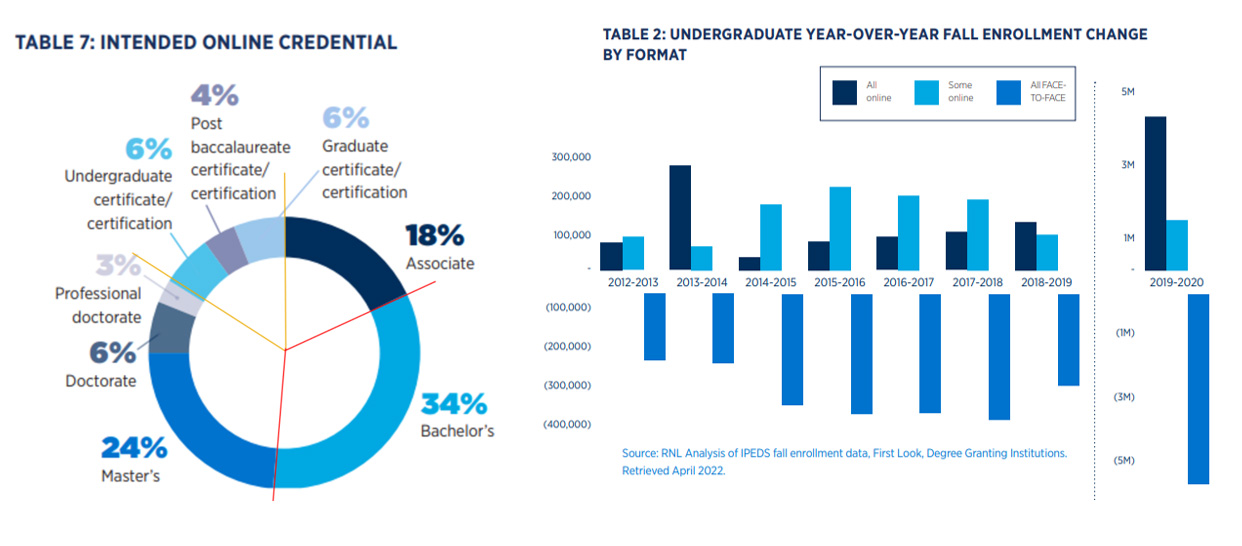enrollment
Online Bachelor’s Programs Are Your Greatest Market Opportunity
“Choosing to only offer classroom bachelor’s programs will not force students seeking online study to choose between an online program and your classroom program. Rather, they will be driven to another online program elsewhere, possibly of lesser quality than you could offer.” – Emily Wood, EdD, Vice President of Instructional Design, RNL.

Emily Wood is one of RNL’s personal “gold mines.” She has a way of enunciating the case for online education with the clarity and simplicity that makes people listen. When I asked her if we could discuss her thoughts on how to convince institutional leaders and stakeholders to expand online bachelor’s programs, she was happy to do so, but warned me that there was a lot to talk through.
Why bachelor’s programs? Because data in RNL’s 2022 Online Student Recruitment Report indicate that the greatest—at least partially—untapped opportunity in the online education space is at the bachelor’s level. More than one-third of prospective online students (the largest proportion) plan to enroll in such a program (see Table 7 below). This is reinforced by IPEDS data that indicate that since 2012, the numbers of undergraduates choosing all online courses has increased every year while the number choosing all classroom courses has decreased (see Table 2 below).

At many institutions, the online focus has been at the master’s level, with increasing discussion of credit-bearing certificates and other non-degree options. While demand for certificates is on the rise, the revenue and enrollment potential for such options will never match what is staring institutions in the face—more online bachelor’s programs.
Emily indicated that many institutional stakeholders have reservations about offering online bachelor’s programs. Why does she think this is the case? She responded, “There are often as many—or more—arguments against offering online bachelor’s programs than for it among institutional stakeholders. They’re concerned that they will cannibalize the classroom programs, or that bachelor’s students are not ready for online study, or that undergraduates need the wrap-around campus experience, or even that offering online versions of programs will spread faculty too thin.”
Emily says she will often respond first by saying, “the reality of the oncoming enrollment challenge is that with the demographic shifts with which we are already contending, serving nontraditional undergraduate audiences is increasingly not an option but a necessity—and these audiences want online study. This is not to say that there will be no traditional-age students who want online study, but the bulk will be older or more experienced students who bring previously earned credit to the table.”
This matches RNL data from the 2022 study in which all but 13 percent of online bachelor’s students bring at least some credit when they enroll in an online program. But they don’t bring as much as you may think. Only 15 percent bring 60 credits or more, and about half bring 45 or less. Emily thinks that this often comes as news to some on campus. “The idea of ‘degree completion’ is not to only offer the upper level courses. Online bachelor’s programs have to offer the lower level courses, too, which can also often serve classroom traditional students who may need to pick up a course here or there.”
As the conversations on campus develop, Emily will often suggest something that is quite powerful in converting at least some of the skeptics: “Choosing to only offer classroom bachelor’s programs will not force students seeking online study to choose between an online program and your classroom program. Rather, they will be driven to another online program elsewhere, possibly of lesser quality than you could offer.”
Here is a transcript of our conversation, edited for length and readability.
A sizable portion of students are indicating that they want to enroll in an online bachelor’s program. Why is that?
Emily Wood: Although the typical online bachelor’s student is an older student or one with previous college credit, we’re seeing a really interesting trend, especially among younger students toward a greater interest in online programs driven by a couple of different things. We can’t ignore Covid and that the impact it has had on these younger students. Many of them completed as many as three of their high school years in some sort of online (or emergency remote) experience. This has really increased their tolerance for, and interest in, integrating online experiences within their life and making them feel that it is natural for them to engage in online education.
We’re also seeing trends with employers toward an embrace of online education. Northeastern University published an interesting report in 2021 that focused on the future of higher education and the workplace. They documented a greater tolerance of online education and greater acceptance of online credentials. In fact, they reported that 71 percent of C-suite executives said that an online credential is either generally equivalent or higher quality when compared to in-person. We have not really ever seen that level of acceptance coming from employers until now.
The link between greater numbers of traditional-age students being comfortable with online study and employer acceptance of online credentials is important because this generation of students—like older students over the longer term—are very focused on career outcomes and what sort of job they will be able to get. They may wonder, “Is this going to be something that employers in my area or employers in my industry are going to value?” So the greater acceptance of employers is likely to trickle down to more and more traditional-age undergraduates.
“We’ve got to stop thinking that the classroom experience is the only ‘gold standard’ of what the college experience can be.”
You also cannot forget the generational difference. These younger students have been having digital experiences since they were born. How do we square that with the assumption of many campus stakeholders that traditional-age students will always want to have the in-person, campus college experience? The assumption that 100 percent of these students want that is really dangerous. Many will, but some will not.
As I talk with campus stakeholders, I try to remember that most college administrators are now a couple of generations removed from traditional-age students. While the on-campus experience might have been very, very important for them as they were coming of age, that may not be the case for today’s students. There are too many pressures, time, expense, the stress of getting a job, and then the accumulated experiences of the pandemic years. In the design world in which I operate, we say “Remember, you are not the user.”
What’s at stake in focusing on online bachelor’s programs as opposed to programs at other levels?
Emily Wood: Anyone who has spent time on campus over the years has heard about the concern of cannibalizing the traditional campus-based residential programs by new online programs. That remains one of the most frequent arguments against online bachelor’s programs, despite there being limited data behind these fears and students telling us this is not the case.
Institutions need to recognize that for many of these students, their choice is not whether they’re going to enroll in an online program or a classroom program with you. Their intentions for online study is already decided. So really, it’s a choice of whether they will enroll in your online program or whether they enroll in another institution’s online program.
Western Governor’s University and Southern New Hampshire University are seeing greater numbers of traditional-age students coming into their programs. Both of these institutions have largely served adult students. That’s who they’re marketing to, that’s who they’re really geared towards. But the previous trickle of traditional-age students has increased considerably. I suspect that this represents growing numbers of traditional students who aren’t getting what they need from their local universities or their local colleges if they don’t have online programs. Rather than going to the university nearby that could offer them the wrap-around services inherent in a local setting, more traditional-age students are enrolling in these institutions that really were not designed for them.
I also think we have to consider what’s at stake here, and we have to be careful. Because we are seeing that there’s a growing number of younger traditional-age students who are interested in online bachelor’s degrees, but the overwhelming majority of students who intend to enroll in online bachelor’s degrees still are adult students or nontraditional students. And as we’re thinking about how to prepare ourselves for the impending enrollment cliff of 2025 where there’s going to be a sharp decline in traditional-age students, we need to consider both populations as we’re developing these online programs.
Tune in next month to read Emily’s thoughts about what institutions need to do in order to ensure that their online bachelor’s programs are of the highest quality while also meeting the demands of the online student of today.
Elevate the online learning experience with expert instructional design
RNL’s Instructional Design team is made up of industry experts in education and technology. Talk with us about how you can develop new courses and optimize your current ones to transform your online course offerings into the best of the best.
